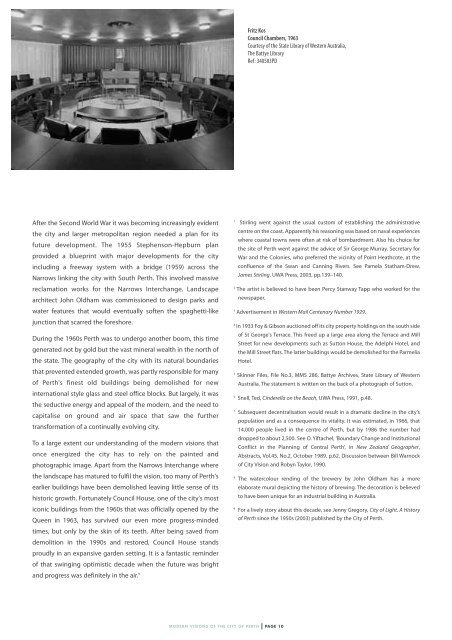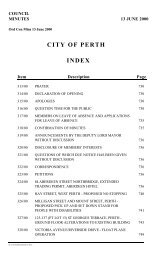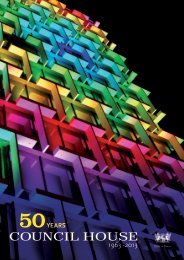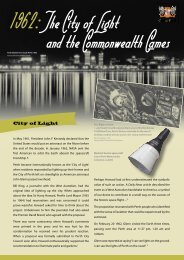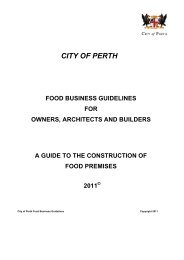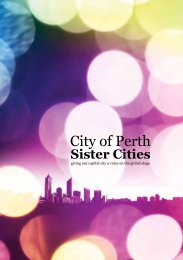modern visions - City of Perth
modern visions - City of Perth
modern visions - City of Perth
Create successful ePaper yourself
Turn your PDF publications into a flip-book with our unique Google optimized e-Paper software.
Fritz KosCouncil Chambers, 1963Courtesy <strong>of</strong> the State Library <strong>of</strong> Western Australia,The Battye LibraryRef: 340583PD1After the Second World War it was becoming increasingly evident Stirling went against the usual custom <strong>of</strong> establishing the administrativecentre on the coast. Apparently his reasoning was based on naval experiencesthe city and larger metropolitan region needed a plan for itswhere coastal towns were <strong>of</strong>ten at risk <strong>of</strong> bombardment. Also his choice forfuture development. The 1955 Stephenson-Hepburn planthe site <strong>of</strong> <strong>Perth</strong> went against the advice <strong>of</strong> Sir George Murray, Secretary forprovided a blueprint with major developments for the city War and the Colonies, who preferred the vicinity <strong>of</strong> Point Heathcote, at theincluding a freeway system with a bridge (1959) across the confluence <strong>of</strong> the Swan and Canning Rivers. See Pamela Statham-Drew,James Stirling, UWA Press, 2003, pp.139–140.Narrows linking the city with South <strong>Perth</strong>. This involved massivereclamation works for the Narrows Interchange. Landscape2The artist is believed to have been Percy Stanway Tapp who worked for thearchitect John Oldham was commissioned to design parks and newspaper.water features that would eventually s<strong>of</strong>ten the spaghetti-like3Advertisement in Western Mail Centenary Number 1929.junction that scarred the foreshore.4In 1933 Foy & Gibson auctioned <strong>of</strong>f its city property holdings on the south side<strong>of</strong> St George's Terrace. This freed up a large area along the Terrace and MillDuring the 1960s <strong>Perth</strong> was to undergo another boom, this timeStreet for new developments such as Sutton House, the Adelphi Hotel, andgenerated not by gold but the vast mineral wealth in the north <strong>of</strong> the Mill Street flats. The latter buildings would be demolished for the Parmeliathe state. The geography <strong>of</strong> the city with its natural boundaries Hotel.that prevented extended growth, was partly responsible for many5Skinner Files, File No.3, MMS 286, Battye Archives, State Library <strong>of</strong> Western<strong>of</strong> <strong>Perth</strong>'s finest old buildings being demolished for new Australia. The statement is written on the back <strong>of</strong> a photograph <strong>of</strong> Sutton.international style glass and steel <strong>of</strong>fice blocks. But largely, it was6Snell, Ted, Cinderella on the Beach, UWA Press, 1991, p.48.the seductive energy and appeal <strong>of</strong> the <strong>modern</strong>, and the need to7Subsequent decentralisation would result in a dramatic decline in the city'scapitalise on ground and air space that saw the furtherpopulation and as a consequence its vitality. It was estimated, in 1966, thattransformation <strong>of</strong> a continually evolving city.14,000 people lived in the centre <strong>of</strong> <strong>Perth</strong>, but by 1986 the number haddropped to about 2,500. See O. Yiftachel, 'Boundary Change and InstitutionalTo a large extent our understanding <strong>of</strong> the <strong>modern</strong> <strong>visions</strong> thatConflict in the Planning <strong>of</strong> Central <strong>Perth</strong>', in New Zealand Geographer,once energized the city has to rely on the painted and Abstracts, Vol.45, No.2, October 1989, p.62. Discussion between Bill Warnockphotographic image. Apart from the Narrows Interchange where <strong>of</strong> <strong>City</strong> Vision and Robyn Taylor, 1990.the landscape has matured to fulfil the vision, too many <strong>of</strong> <strong>Perth</strong>'s8The watercolour rending <strong>of</strong> the brewery by John Oldham has a moreearlier buildings have been demolished leaving little sense <strong>of</strong> its elaborate mural depicting the history <strong>of</strong> brewing. The decoration is believedhistoric growth. Fortunately Council House, one <strong>of</strong> the city's most to have been unique for an industrial building in Australia.iconic buildings from the 1960s that was <strong>of</strong>ficially opened by the9For a lively story about this decade, see Jenny Gregory, <strong>City</strong> <strong>of</strong> Light. A HistoryQueen in 1963, has survived our even more progress-minded <strong>of</strong> <strong>Perth</strong> since the 1950s (2003) published by the <strong>City</strong> <strong>of</strong> <strong>Perth</strong>.times, but only by the skin <strong>of</strong> its teeth. After being saved fromdemolition in the 1990s and restored, Council House standsproudly in an expansive garden setting. It is a fantastic reminder<strong>of</strong> that swinging optimistic decade when the future was brightand progress was definitely in the air. 9MODERN VISIONS OF THE CITY OF PERTH PAGE 10


